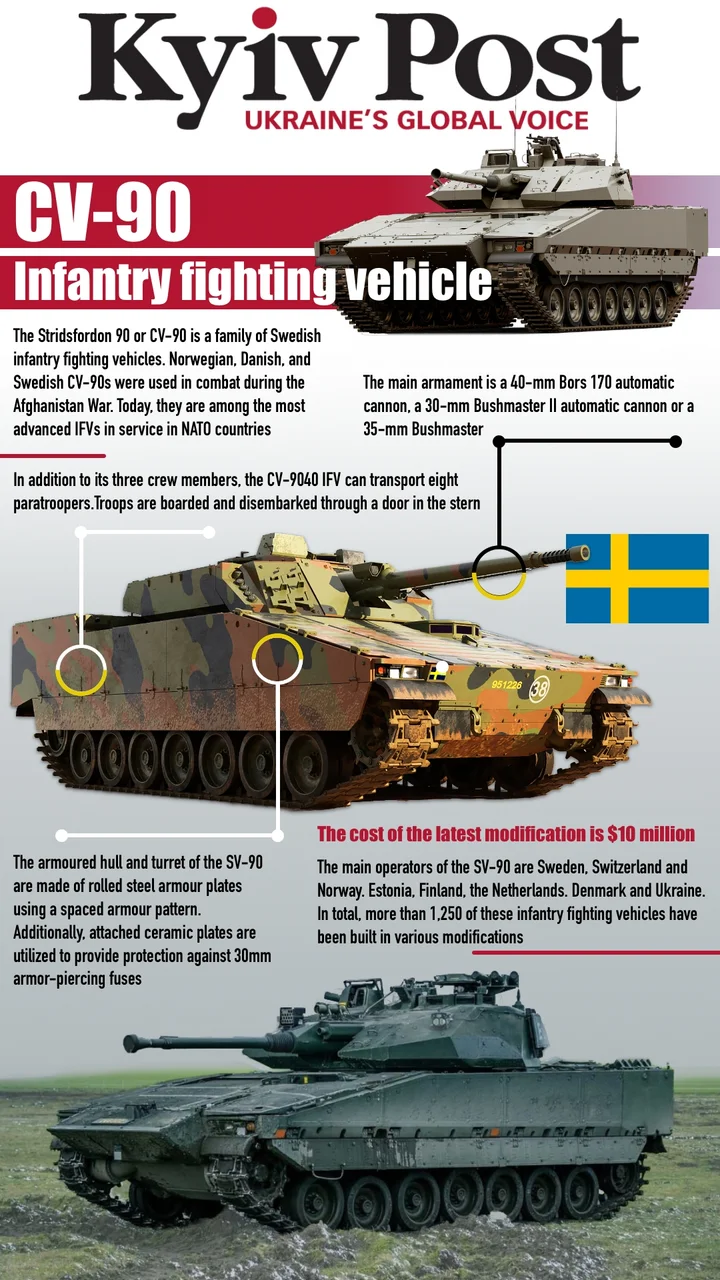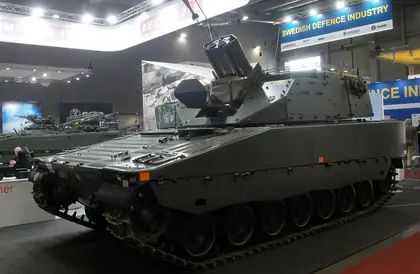Sweden has provided Ukraine with about 50 of its top-notch IFVs. This is enough to fully re-equip one mechanized battalion with these technologically advanced vehicles.
Ukrainian crews officially finished training to use the vehicles in June 2023, under an accelerated program in Sweden. Now the vehicles are with their Ukrainian assault brigades.
JOIN US ON TELEGRAM
Follow our coverage of the war on the @Kyivpost_official.
The Swedish IFVs are helping to fight and break through enemy defenses and are an important part of Ukraine’s counteroffensive.
- View the most up-to-date Ukraine news articles published today.
- Read the newest Ukraine news stories published today.
Ukrainian military gets a serious upgrade with Swedish IFVs
Ukraine’s military is widely using these IFVs for infantry fire support. The Swedish CV-90 is a huge improvement for Ukraine’s defenders. The Soviet BMP-1 and BMP-2 are like “Zaporozhets” (an old Soviet car model), while the CV-90 is like a true “Mercedes.”
It is very convenient to work at night with the CV-90. It isn’t visible in thermal imaging (thanks to the Barracuda camouflage system), while the CV-90 gunner can see targets perfectly through its built-in thermal imager.
The Swedish IFVs have also proven to be relatively quiet compared to other vehicles of their class. The engine noise is barely audible from a distance of 200 meters, which further reduces the chances of the vehicle being detected by the enemy.
The Swedish IFVs are much more comfortable than Soviet ones and they do their job protecting people. The most impressive thing is that they take care of the soldiers.

ISW Russian Offensive Campaign Assessment, January 14, 2025

Frankly speaking, Soviet armored personnel carriers (APCs) were cheap vehicles whose designers did not care much about the fate of the crew. The CV-90 is a completely different story.
The CV-90 was developed with the understanding that it is an expensive vehicle, but the most valuable thing in it is the people.
What are these armored vehicles?
The CV-90 is a modern series of infantry fighting vehicles developed by Swedish company BAE Systems Hagglunds. They are highly maneuverable, reliable, and heavily armed. They also have a high level of protection, helping to ensure the safety of the crew and infantry during combat.
The acronym CV-90 stands for Combat Vehicle 90. The original Swedish name, “Stridsfordon 90,” has a similar meaning. This family of infantry fighting vehicles appeared in the early 1990s specifically for use in the challenging subarctic Scandinavian climate. The first units were delivered for service in 1994.
In total, more than 1,250 of these IFVs were built in various configurations, a significant number of which were exported to other countries.
The unified chassis of the Swedish vehicle allows for a significant expansion of uses.
The CV-90 can provide infantry support through firepower, serve as a command vehicle, function as an air defense asset, act as a 120 mm self-propelled twin-barreled mortar, perform electronic warfare tasks, and also serve as an armored evacuation vehicle.
The key lies in the fact that the turret in modern combat vehicles is a fully integrated combat module equipped with all the necessary electronics and armament to perform specific tasks.
The configurations of these IFVs significantly differ depending on the requirements of the ordering country. For instance, the Swedish version of the combat vehicle uses a Bofors turret with a mounted 40 mm automatic cannon.
Export variants may have different turrets, including those with 30 mm automatic cannons like the Mk44 or 35 mm Bushmaster. Additional armor for the vehicle can also be modified based on the specific country and its armed forces' needs.
The CV-90 IFV's crew consists of three individuals: the commander, the gunner, and the driver-mechanic. Additionally, the combat vehicle can accommodate up to eight fully equipped infantry personnel.
As the machine was developed to withstand the Scandinavian climate, it ensures enhanced mobility in snow, mud, and during challenging weather conditions.
The IFV is powered by a V-shaped 16-liter diesel engine with a capacity of up to 770 horsepower capable of accelerating the armored vehicle to up to 70 kph on the road.
CV90 crews can quickly identify enemies, evade detection, destroy targets and safely evacuate the scene.
— BAE Systems, Inc. (@BAESystemsInc) August 9, 2023
The CV90 is the future of the battlefield: proven a superior vehicle in all key combat capabilities to fight and win. #CV90 #IFV #CombatVehicle pic.twitter.com/m2ZwnyyEOZ
Configurations
CV 9040A is the basic and most common variant used by the Swedish army. This combat vehicle is equipped with a 40 mm manually-operated cannon that can fire at infantry, armored vehicles, helicopters and enemy positions at a range of up to 4 kilometers.
In subsequent modifications, the cannon was equipped with a fully automated mechanism.
CV 9040B and CV 9040B1 – are upgraded versions of IFVs for Sweden. They have enhanced armor protection and additional software that allows them to use a new versatile 40 mm ammunition, called 3P.
The key idea here is that different targets require different types of ammunition, and switching between them takes time, which can significantly impact mission results. The new programmable ammunition can operate in six different modes to effectively engage air, surface, and ground targets.
This provides the weapon systems with the highest level of combat adaptability. Each 3P fuze is individually programmed using a computerized fire control system. Just before firing, the fuze is set to the chosen mod.
Furthermore, the CV 9040B and CV 9040B1 are equipped with additional composite armor, which helps protect the vehicle from 30 mm armor-piercing fuses. Many Soviet-era APCs and BMPs that are currently in service with the Russian Federation primarily use such ammunition.
CV 9040C represents the most advanced modification within the Swedish Army. The latest version has received additional protection through the use of Advanced Modular Armor Protection (AMAP) and has also been equipped with an upgraded thermal imaging system.
The most recent modification also includes optics protection against laser beams.
A combat vehicle that protects itself using the latest thermal imaging technologies and through the destruction of enemy munitions
The AMAP is an active defense system for light armored vehicles. Its operation is based on continuously scanning the area around the vehicle within a 10-meter radius. The sensors of the system detect the movement of objects toward the combat vehicle and transmit the data to another sensor.
The second sensor is used to determine the type of approaching ammunition that could pose a threat. All data about the speed and type of projectile are sent to the main computer, which processes the information and automatically initiates the launch of a counter-projectile to neutralize the threat. This system is quite effective against guided anti-tank missiles.
The CV 9040C has additional mine protection at the bottom of the hull, as well as a multi-layer modular Barracuda camouflage system.
The Barracuda camouflage system is the latest technology that helps military vehicles become less visible on the battlefield. This camouflage helps to reduce the visibility of equipment in various spectrums, including thermal.
One of the main advantages of the Barracuda system is its ability to reduce the heat footprint of vehicles and protect them from overheating.
The Barracuda system allows combat vehicles to be less visible on the battlefield, providing an important advantage in operations and reducing the risk of detection and engagement by the enemy.
You can also highlight the text and press Ctrl + Enter






